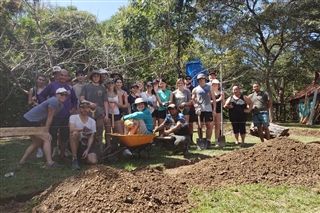This year, 20 students travelled to Costa Rica alongside Señor Dylan Reeves, Mr. Clayton Webb and Ms. Leah Hall.
They spent the first seven days on Isla Chira, which is located in the Gulf of Nicoya. Isla Chira is home to two of the world’s most endangered tropical ecosystems: the tropical dry forest and the mangrove swamp.
“It’s one of the largest tropical dry forests,” said Sr. Reeves. “They base their economy on the production of shellfish that they produce in the mangrove swamps, but they are in danger from climate change because the ocean is becoming warmer, and they are also having a problem with forest fires.”
During their time on the island, the group explored the challenges residents face as they work to conserve these two important ecosystems and helped local community groups with the projects that have been developed to protect them. This included meeting with members of a fishermen’s association that are working to prevent overfishing, speaking with members of a women’s collective whose mandate is to conserve the mangrove swamps, and participating in the Mangrove Swamp Reforestation program.
Each day, a group of students journaled their experiences. Here are some excerpts they wrote about their time on Isla Chira.
-
“Our first whole day began with a beautiful trip through the mangroves, where we were greeted with crocodiles of many shapes and sizes. We explored the ecosystem and learned about the environmental effects of climate change on the local economy and habitats.”“Today we woke up to the sweet smell of banana pancakes, fruit and gallo pinto (a regular dish here). After breakfast, we all put on our work pants and boots and got hard at work. There were three main jobs to do today at La Amistad. Mainly working to combat erosion, building a retaining wall to protect the main house, and covering up pipelines from the hot sun rays.”“Today was the hardest work day yet. We worked 9-5 morning, day, and night. We started off with some work around La Amistad; varnishing and painting cabins, digging trenches, and filling tires. After a quick watermelon break, we hiked the 1.6km “trail” on an incline as a warm-up, which to our surprise we would be clearing in the afternoon.”For the remainder of their trip, our Gryphons headed to Playa Grande on the west coast where the students had the opportunity to work with the sea turtle volunteer program KUEMAR, a non-profit organization that promotes the conservation of marine turtles through research, outreach and voluntary work. They completed a beach clean-up of Nombre de Jesus that yielded over 200 lbs of garbage, participated in exhuming close to 200 baby turtles from their beach nests and released them into the pacific ocean and then did the patrol. Some of the students also participated in a night patrol watching for nesting turtles so that they could then collect and relocate the newly laid eggs.Here is what they journaled about their time in Playa Grande:
-
“After a hearty bean breakfast with the addition of stronger coffee, we walked over to the turtle conservation project. We were given a presentation by two turtle professionals at KueMar. We learnt about the harmful effects of predators and human activities close to the beach.”“Nombre de Jesus was a beautiful stretch of white sand, blue water, and a view of several little islands from the shore. We started off with a beach clean, collecting items washed up on shore from around the world. We found 84 stray shoes, 223 plastic bottles, many kids’ toys and much more…We hopped back on the bus and went back to Nombre de Jesus…We dug out over 170 baby turtles that otherwise would not have made it. After collecting a bucket full of turtles we released them to the sea and placed bets on the turtle to reach the water first. Top 10 life experiences.”At the conclusion of their adventure, the students and staff began their journey home, only to be waylaid in Calgary due to a winter storm that created travel chaos across Canada. Fortunately, an anonymous donor (or “angel” as one family referred to them) stepped forward and arranged for the students and their trip leaders to be flown to Victoria where they were reunited with their families.When asked to describe their service learning adventure to classmates, this is what some students had to say:
-
“This is a once-in-a-lifetime experience and I would not skip it for anything. You learn so much about yourself, your peers and a different environment you would never expect.”“This service trip was focused around the environment and the effects of human infrastructure/pollution on the planet. We worked on smaller projects all under the umbrella of climate change, like mangrove planting and firebreak clearing. The work was difficult, but the payoff was worth all the struggle. We ate great food and bonded with each other. It’s a trip I will remember forever.”Several years ago, our international service trips were started as part of Round Square, but they later turned into GNS-focused trips organized by the school. This change was led by Ms. Sarah McKerlich and Sr. Reeves. The first GNS service trip was in 2007 in Chacala, Mexico where students helped a Habitat for Humanity international arm called Global Village.“During the day we would go work on a house 10 kilometres away,” explained Sr. Reeves. “In the evenings we would do community events with the students from the village, which was wonderful.”The students would have a cooking night, where they learned how to make a dish from Mexico and then they would share a Canadian dish. There were also dance lessons, crafts and games. These service trips to Mexico continued until 2013 but were then shifted to Costa Rica where the school worked with Latin American Service Expeditions inYorkín, which is on the southeast coast on the border of Panama.“We would help them in the Bri Bri Indigenous community of Yorkin, with the development of providing touristic opportunities for people to come and stay and learn about their culture,” said Sr. Reeves. “We would be building living quarters, milling wood, building palapas, stages and different structures.”Being able to take students on these service trips is important for many reasons, including helping others, community engagement, and practising communication and language skills. One of the most important aspects, however, is being able to take learning outside of the classroom.“You can take economics, science, language and all of these things you have learned and really apply it,” said Sr. Reeves. “We are also able to get to know one another on another level, putting yourself in situations you may not be comfortable with, but demonstrating your perseverance to move forward and experience new things and grow from it.”





